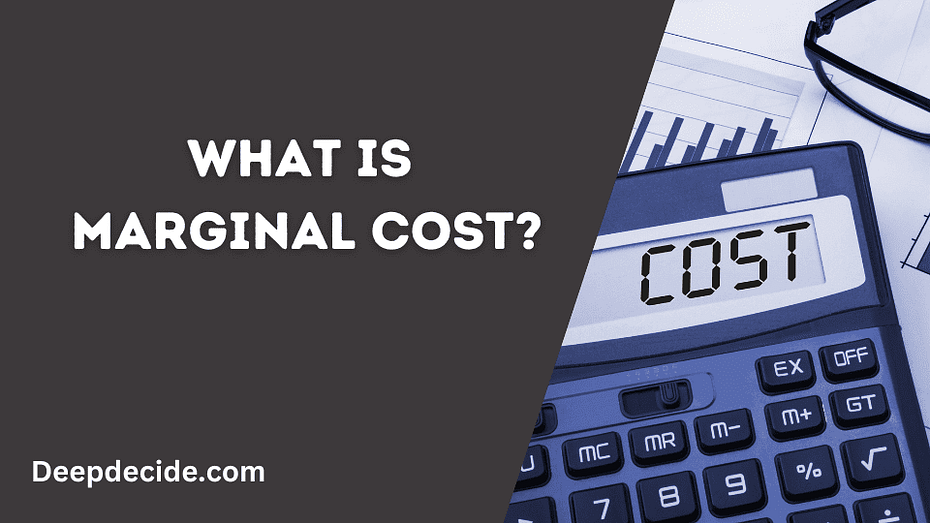Last Updated on: 7th October 2023, 09:46 am
Marginal cost, a fundamental concept in economics and business, plays a crucial role in decision-making for companies aiming to optimize their production and profitability.
Here is the understanding of marginal cost, its formula, calculation methods, examples, and its relationship with marginal revenue.
By delving into these aspects, businesses can enhance their pricing strategies, identify production efficiencies, and ultimately improve their competitive edge in the market.
What is Marginal Cost?
Marginal cost, also referred to as incremental cost, represents the change in the total production cost resulting from the production of one additional unit or the provision of service to one more customer.
It is a key metric that helps businesses determine the optimal level of production and pricing for their products or services.
Marginal cost takes into account both fixed and variable costs, making it an essential tool for evaluating profitability and making informed decisions regarding production and pricing strategies.
Marginal Cost Formula
The formula for calculating marginal cost is straightforward:
Marginal cost (MC) = Change in total cost (ΔTC) / Change in total quantity (ΔQ)
Where:
- MC represents the marginal cost
- ΔTC represents the change in total cost
- ΔQ represents the change in total quantity
Calculating Marginal Cost
To calculate marginal cost, one must follow a series of steps, as demonstrated through an illustrative example involving an e-commerce business selling handmade jewelry:
- Identify the Change in Quantity: Determine the change in the quantity of the product or service. This is typically one unit but can vary based on the number of units being added.
- Calculate Change in Total Cost: Compute the change in total cost resulting from the change in production. Subtract the initial total cost from the new total cost after the change in quantity.
- Calculate Marginal Cost: Divide the change in cost by the change in quantity to obtain the marginal cost.
Marginal Cost Example
Consider a scenario involving an e-commerce business specializing in handmade leather jackets. Initially, the business produced 50 jackets per week at a cost of $2,000. By increasing production to 60 jackets per week, the total cost rises to $2,450.
The marginal cost of producing 10 additional leather jackets can be calculated as follows.
- Change in quantity = 60 jackets – 50 jackets = 10 jackets.
- Change in total cost = $2,450 – $2,000 = $450.
- Marginal cost = $450 / 10 = $45.
The marginal cost of producing one additional leather jacket (in batches of 10) amounts to $45. This insight allows the business to determine optimal pricing, ensuring profitability and facilitating informed production decisions.
Marginal Cost Curve
When visualized on a graph, the marginal cost curve typically exhibits a U-shaped pattern. At the outset, costs are relatively high until the break-even point is reached, covering fixed costs.
Subsequently, costs remain relatively low for a period before gradually increasing due to expenses associated with increased production, such as additional labor and equipment.
Creating a marginal cost curve involves the following steps:
- Identify Cost Drivers: Understand the factors influencing costs, such as labor, raw materials, and shipping.
- Calculate Marginal Cost at Different Production Levels: Compute the marginal cost for varying quantities of the product.
- Plot the Curve: Represent the quantities on the x-axis and the corresponding cost per units on the y-axis.
- Analyze the Curve: Examine the curve to make strategic decisions. Falling marginal costs (economies of scale) may indicate potential for increased production, while rising marginal costs (diseconomies of scale) warrant careful consideration of production expansion or efficiency improvements.
Maintaining a product price above the marginal cost is essential for profitability. If the price falls below the marginal cost, businesses should review their pricing strategy or seek methods to reduce costs.
Marginal Cost and Marginal Revenue
Marginal cost and marginal revenue work in tandem to optimize production levels. The point of optimal production occurs when marginal cost equals marginal revenue (MC=MR). Although these concepts are interconnected, they have distinct definitions:
- Marginal Cost: The additional cost incurred by producing one more unit of a product or service.
- Marginal Revenue: The extra revenue generated from selling an additional unit of a product or service.
The optimal quantity to sell is where marginal cost intersects with marginal revenue, as shown on the marginal cost curve. Businesses can maximize profits by producing and selling units as long as marginal revenue surpasses marginal cost.
Conclusion
In the dynamic landscape of business, understanding and effectively utilizing the concept of marginal cost is paramount.
By comprehending the nuances of calculating marginal cost, interpreting its curve, and recognizing its relationship with marginal revenue, businesses can fine-tune their production processes, enhance profitability, and gain a competitive edge in the market.
Armed with this knowledge, entrepreneurs and decision-makers can make informed choices that lead to a more prosperous and efficient business journey.



